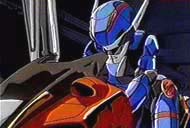
Bubblegum Crisis
The fanboy hype machine in the anime community has always worked in overdrive. Long before the machine got behind Hellsing, Neon Genesis Evangelion, Ghost in the Shell, or Akira, it promoted Bubblegum Crisis. A set of 8 OVAs released from 1987 to 1990, Bubblegum Crisis was at the time considered by many to be the ultimate direct-to-video series. It spawned both prequel and sequel OVA series, and it recently made the leap to TV in a dramatic re-visioning. At its initial release, the cyberpunk flavorings and female empowerment combined with great action sequences and killer androids on the loose made it seem unparalleled. Looking back on the whole series, Bubblegum Crisis is not as good as it should be for such a humongously popular show, but areas of it are still high quality and bits of it are downright fantastic.
It's 2032, MegaTokyo. The monolithic Genom Corporation has control over many world markets, specializing in a variety of technological systems useful for modern warfare. Their prize creation is the Boomer, an android-like series of automatons that can often pass for humans but come complete with metallic exoskeletons and weapons worthy of a small platoon. Obviously, these guys are dangerous, and often Genom uses them for less-than-moral schemes, sending them running amuck through the city. The AD Police, the force charged with handling Boomer activity, is all but worthless. Mason, the local Genom head, seems determined to find a way to make himself not only top dog of the company but leader of the free world...well, at least free for now.
Enter the Knight Sabers, a team of women determined to challenge the authority of the Boomers and Genom's stranglehold on the globe. Each has a unique background and history, but there are two main players: Sylia and Priss. Sylia is the daughter of a brilliant scientist who worked on the Boomer project and was murdered by Genom when he was no longer an asset. It's Sylia who pays the bills to keep the Knight Sabers running, and she's the backbone of the team. However, it's Priss who's its headstrong center. Priss' cover is as a J-Rock singer, and she is known throughout the clubs and underground music scene. Her involvement with the Knight Sabers originally seems to be mostly out of a desire to test her limits and to make some nice cash, but she soon becomes personally involved when she realizes the depths of Genom's atrocities.
Bubblegum Crisis is a plot-driven series, and its successes and failures lean on the strengths and weaknesses of each episode's story. The first episode, "Tinsel City," gets things started off right, introducing us to the characters and getting a multi-episode plotline started under a backdrop of crisp animation and an excellent soundtrack. (Although BGC was known for its soundtracks, the first episode is by far the best scored and contains the best vocals, and should be seen if nothing else for that.)
It appears that the production team lost its way soon afterwards, though. Episodes two and three have at best mediocre animation, even reusing artwork between the two at one point, and their plots feel laden and repetitive. It's as if the team of developers went on autopilot, not realizing the potential of the property they had in their hands. Frankly, I stopped watching the show after these two episodes several years ago, and I'd not seen the complete series until just now. Nevertheless, these two episodes contain plot points that become important later on in the series.
Thankfully, the show gets back on track with episode four, "Revenge Road." It's actually not a part of the overarching storyline, but it's so well done both in plot and animation that it makes up for the sins of the previous two installments. The next three chapters take us further down the plotline started at the beginning, and though they each have weak moments, they are still entertaining. The show ends a bit weakly on "Scoop Chase," which focuses on a minor character instead of wrapping up any leftover story threads. The last four episodes all have great animation, though, and by the time we hit the final chapter, it's pretty amazing how far the look has come.
Because of problems between the production companies making Bubblegum Crisis, the show stops without any major resolution. This was eventually handled in a sequel called Bubblegum Crash. With different design styles, different voice actresses, and some plot changes from Crisis, it didn't go over well with either Japanese or American fans. Those craving resolution of the whole Genom storyline can look to Crash for a continuation, though it's generally agreed that the show is not nearly as good.
Watching Bubblegum Crisis now is sometimes downright...well, quaint. For a show that was so popular because of its technological viewpoint, it's funny how much of it looks out of place now. Notice, for example, the fact that nobody has cell phones--the characters repeatedly use phone booths. Granted, the phone booths have video teleconferencing, but seeing that the latest cell phones are only steps away from this, it seems remarkably out-of-step. There's also no real concept of the Internet--at one point, a data letter disc is sent via postal mail--though there is networking of computers. It's funny to see how a show praised for its future outlook could be so off so soon.
But unfortunately, that's not the only problem with BGC. The show has a nasty habit of repeating itself. (I'm going to mention a minor spoiler or two here, so if you're not interested, skip ahead to the next paragraph.) Fully half the episodes involve the "stunning" death of an innocent character. Then three of the other four have revenge as their primary theme. For crying out loud! Can't anybody come up with an original plotline? Although "Scoop Chase" is a minor episode, it's the only one where we aren't looking at the same story. Even then, the only major difference is that the innocent character doesn't die--for once. The stories involving innocent deaths and vengeance are different enough to be interesting, but watching the whole in one or two sittings, the parallels are a little too obvious.
Besides the repeated plotlines, there's a severe problem with character development. For all the battles that the Knight Sabers face and all the acquaintances that get killed off over the course of events, you'd think these folks would have some depth to them. Perhaps it's because there's too much story for 30-45 minute episodes, but the character dynamic gets shafted. Without any growth, the characters start becoming ciphers who act more like their character types than real people. It's an unfortunate choice.
But what makes Bubblegum Crisis beloved even now, even fifteen plus years after its arrival? Ultimately, it's the mix of mecha, machines, and action. Crisis has absolutely beautiful action sequences in every single episode, animated flawlessly. For those who aren't looking for significant depth, Crisis delivers top-notch battles. It also has some truly nasty villains. They aren't always talkers; they are schemers and doers, slimy folks you wouldn't want to meet in a brightly sunlit alley, let alone a dark one. And if you want atmosphere, BGC will sell it to you by the yard. The dark murkiness of MegaTokyo is a character unto itself.
There's also an ambiguity in some of the minor characters that is compelling. There are plenty of people bringing about retribution to others in this series, but those payback-minded individuals are usually normal souls driven to retaliation by events beyond their control. At which point would any of us, wronged deeply enough, withdraw the hand of forgiveness and extend the hand of smackdown? It's these human drama elements that raise the show beyond the sum of its parts.
I've been having trouble putting a letter grade on Bubblegum Crisis as a whole because its parts are so varied in quality. The first and fourth episodes are good A quality episodes, and episodes five through seven are at least in the high Bs. The eighth episode is just OK, though, and the second and third episodes are awful. So take my grade with a grain of salt if you have plenty of patience to get through the dull spots or love sci-fi cyberpunk material. I think it's a fair ranking, all things considered. Bubblegum Crisis was a milestone in its day, and its significance isn't overstated. It's often a good ride through a vision of the future...but it's not my personal favorite, despite the raves it's received over the years.
Bubblegum Crisis -- violence (some mildly graphic), brief nudity, profanity -- B

